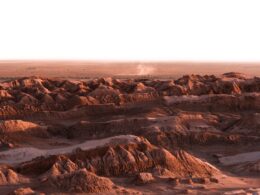The most important concept in environmental science is called “planetary boundaries” which represents a conceptual framework for determining the safe operating space for humanity within Earth’s ecological limits. This framework was first introduced by Johan Rockström and colleagues in 2009. It comprises nine critical Earth system processes-essential to maintaining the stability of the planet. Severe risks and threats to human well-being and integrity in ecosystems are posed if these boundaries are crossed.
The Nine Planetary Boundaries
1. Climate Change:
Threshold: The threshold established for atmospheric CO₂ concentration should be 350 parts per million (ppm) because it will provide a safe limit by preventing dangerous climate impacts in relation to extreme weather, sea-level rise, and disruptions of ecosystems.
Present Condition: CO₂ has already breached 417 ppm currently and that too with a huge margin. This increase in the past decades has been caused primarily by fossil fuel combusting, deforestation, and industrial processes.
2. Intact Biosphere:
Focus: This focus relates to biodiversity loss as well as extinction rates of species-thus, important features for ecosystem resilience. Ecosystems provide key services, such as providing pollination, purifying water and regulating climate.
Threshold: The extinction rate of species must not exceed 10 extinctions per million species per year.
Status: Current rates suggest that extinction is occurring at 100 to 1,000 times the rate of the past, if one includes human effect in it. This is a serious violation indeed.
3. Stratospheric Ozone Depletion:
Importance: Ozone protects life on Earth from the damaging impact of ultraviolet (UV) radiation coming from the sun.
Threshold: Less than 5% below pre-industrial levels is deemed to be within the threshold.
Present Status: This boundary is within safe limits now due to global efforts such as the Montreal Protocol that phased out these ozone-depleting substances and recovery is moving in the right direction.
4. Ocean Acidification:
Consequence: Higher CO₂ concentrations cause increased carbonic acid in the oceans, which impacts marine life, especially organisms with calcium carbonate-based shells or skeletons. These include corals and shellfish.
Threshold: Mean surface seawater saturation should not be less than 80% of pre-industrial values.
Status: Although this threshold has yet to be breached so far, it is still under observation because the rate of CO₂ is increasing and may have effects in the marine ecosystems.
5. Biogeochemical Flows (Nitrogen and Phosphorus Cycles):
Nitrogen Cycle:
CtB Threshold: The safe limit is set at 62 teragrams (Tg) of nitrogen per year.
Status: Human activities have risen the nitrogen inputs to about 190 Tg/year mainly through fertilizers and combustion of fossil fuel.
Phosphorus Cycle:
Threshold: A threshold of 11 Tg/yr. is assumed.
Current Status: Current phosphorus inputs amount to around 22.6 Tg/year, mainly through agricultural runoff and wastewater.
6. Land-system change:
Significance: This boundary refers to deforestation, urbanization, and land degradation that disrupt ecosystems and contribute to climate change.
Current Status: Land-use changes in large dimensions have been caused globally, specifically in the tropics by agriculture and urban expansion, which have resulted in violations of this boundary.
7. Freshwater Use:
Importance: Freshwater resources serve important purposes, from drinking water to irrigation for agriculture, and industrial purposes. Over-extraction can cause rivers and aquifers to disappear.
Threshold: The boundary is defined by sustainable use across the entire water cycle over land.
Status: Most regions suffer from extreme water scarcity, either through unsustainable consumption levels or pollution, which manifests as a breach.
8. Atmospheric Aerosol Loading:
Definition: Aerosols are small particles suspended in the atmosphere that can impact climate through altering the formation of clouds and solar radiation.
Current Status: This boundary has not yet been crossed internationally, but localized industrial activity-based pollution threatens the environment and needs to be managed diligently.
9. Introduction of New Entities:
Scope: It encompasses synthetic chemicals such as plastics, heavy metals, and other pollutants that may harm living organisms and the environment.
Threshold
Ideally, there should be zero introduction of harmful substances into the environment. Status: This limit has been surpassed due to the pervasiveness of anthropogenic pollution, causing devastating ecological effects. Implication of Crossing Borders Ended Once these planetary boundaries are crossed, it does not trigger a catastrophe that happens overnight but increases the likelihood of wholesale environmental changes that will destabilize the Earth systems.
The interconnected nature of these boundaries means that crossing one boundary may intensify pressures on others: For instance, various conditions brought forth by climatic change make habitats unfavorable to different species, resulting in biodiversity loss. – Overloading of nutrients associated with agricultural runoff can also initiate algal blooms in water bodies, thereby further degradation of water quality and also influence freshwater supply.
Conclusion
This framework of planetary boundaries is a critical guide for the development and the understanding of limits by which humanity can be productive within a sustainable environment. To follow these boundaries, constant monitoring, with proactive measures, must be set in place to ensure a stable environment for future generations.
Such challenges demand the global cooperation of innovative technology, policy-making, and societal commitment toward sustainability in all sectors.
Thanks for reading! Keep exploring alloftop.com for the latest in tech, science, business, lifestyle, and beyond. Stay informed with us, and always be ahead of the curve!










